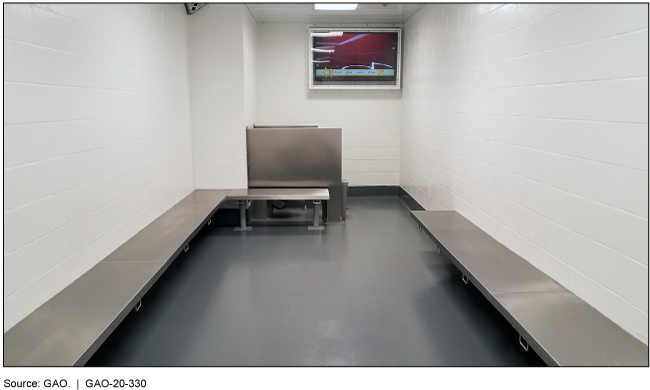Immigration Detention: Care of Pregnant Women in DHS Facilities
Fast Facts
U.S. Immigration and Customs Enforcement detained pregnant women more than 4,600 times from 2016-2018. Most detentions lasted 1 week or less.
ICE has policies and standards related to the care for pregnant women that vary by facility type, with some having more requirements than others. ICE is updating its policies and standards to address gaps.
At facilities it inspected, ICE generally found at least 79% compliance with inspection measures related to pregnancy care.
Most ICE detentions started with U.S. Customs and Border Protection arrests. CBP mostly relies on offsite pregnancy care, but plans to enhance medical support at select facilities.
Holding room at a CBP port of entry

Room with white cinderblock walls and stainless steel benches
Highlights
What GAO Found
GAO's analyses of U.S. Immigration and Customs Enforcement (ICE) and U.S. Customs and Border Protection (CBP) data on pregnant women found:
- ICE detained pregnant women over 4,600 times from calendar year 2016 through 2018, with more than 90 percent resulting from CBP arrests.
- Sixty-eight percent of these detentions were for 1 week or less, while 10 percent were for more than 30 days.
- Seventy-eight percent of these initial detentions occurred at facilities staffed with ICE medical personnel.
ICE has policies and detention standards that address a variety of topics regarding the care of pregnant women, such as pregnancy testing requirements, for which non-governmental organizations, professional associations, and federal agencies have issued recommended guidance. However, some facility types—which vary based on who owns, operates, and provides medical care at the facility—did not address all these pregnancy-related topics in their policies and standards, such as prenatal vitamins, as of December 2019. ICE has plans to address the gaps GAO identified in these facility types, including updating some of its policies and detention standards in February 2020. In regards to CBP, its facilities are designed for holding individuals for no more than 72 hours, and therefore are not equipped to provide long-term care. Nonetheless, CBP has some policies and standards regarding pregnant women for its short-term facilities, including those related to nutrition and the circumstances in which restraints could be used.
GAO's analyses of inspections and complaint mechanisms offered the following insights into the care provided to pregnant women:
- ICE inspections found 79 percent or greater compliance with most of its pregnancy-related performance measures. For example, inspections found 91 percent of pregnant woman were seen by an obstetrician-gynecologist within 30 days of pregnancy confirmation, from December 2016 through March 2019. According to ICE officials and agency documentation, ICE has processes in place to address non-compliance. Additional inspections identified pregnancy-related issues at 13 facilities from January 2015 through July 2019. The facilities or ICE have taken actions to address the issues.
- CBP generally relies on offsite care for pregnant women, and as a result has limited information on care CBP provided. However, CBP has efforts underway to enhance medical support at selected facilities.
- Over 100 complaints were filed about ICE's and CBP's care of pregnant women from January 2015 through April 2019. Of these complaints, 3 were substantiated or partially substantiated, and 24 were unsubstantiated or partially unsubstantiated. In most cases there was not enough information for the investigating agency to determine whether proper care had been provided.
Why GAO Did This Study
In December 2017, the Department of Homeland Security (DHS) updated its policy on pregnant women, removing language that stated that pregnant women would generally not be detained except in extraordinary circumstances or as mandated by law. Within DHS, CBP temporarily holds individuals in its facilities and processes them for further action, such as release or transfer to ICE. ICE manages the nation's immigration detention system. ICE utilizes various facility types to detain individuals, such as those owned and operated by ICE and contract facilities. GAO was asked to review issues related to the care of pregnant women in DHS facilities.
This report examines (1) what available data indicate about pregnant women detained or held in DHS facilities, (2) DHS policies and standards that address the care of pregnant women, and (3) what is known about the care provided to pregnant women in DHS facilities.
GAO analyzed available DHS data and documents from calendar years 2015 through 2019, including detention data, inspection reports and data, and complaints; reviewed policies related to the care of pregnant women; and interviewed agency officials and three national non-governmental organizations. GAO also interviewed a non-generalizable sample of 14 pregnant women detained or released by DHS and five non-governmental organizations in four field locations that had the greatest number of detentions of pregnant women, among other things.
For more information, contact Gretta Goodwin at (202) 512-8777 or goodwing@gao.gov.
